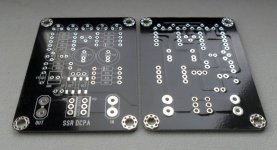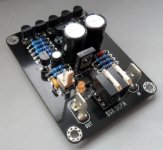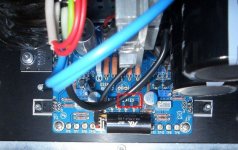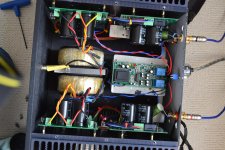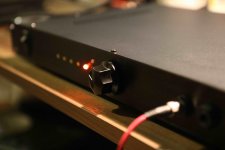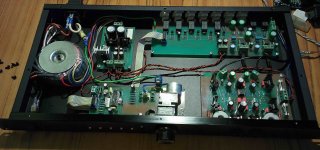Hello Alex
<snip>
Hi,
Yes you right , so please erase my name from your PCB , and please forgive me for impertinence .
Attachments
There is no problem Alex and I do not see any impetinence, it is normal to defend his work and in addition I learned a lot of tricks on Sprint Layout thanks to you.Hi,
Yes you right , so please erase my name from your PCB , and please forgive me for impertinence .
Yes the blue pcb in my USSA-5 is your excellent job.
I did not understand all the questions because the online translator gives me anything.
<snip>
Hi Project16,
Despite the shortcomings of the online translator, you've managed to answer my questions.
Nice work all round!
Edit: I am using a CRC power supply board designed by you in one of my builds - working very well, thank you.
Last edited:
New 50W SECA PCB layout.
Chassis design.
More info here:-
New 50W SECA kit soon to be available | SECA
An externally hosted image should be here but it was not working when we last tested it.
Chassis design.
An externally hosted image should be here but it was not working when we last tested it.
More info here:-
New 50W SECA kit soon to be available | SECA
Searched up seca amp
seems to use only 4pairs of transistors on a very big heatsink. I'd deffintly recomend having more output transistors like 6-8 pairs. Without enough transistors heat can't transfer and internal temp is much higher than case temps of transistor.
From my exprience with smaller heat sink and about 120w of quisent power on 3 pairs. The heat sink runs 50-55c but transistors are starting to lack heat transfer, the case is about 10c hotter than heat sink even with very thin mica and heat sink paste. Also transistor internal temperature is about 20c above heat case temps.
One4Audio 50W SECA PCB - pink fish media
I don't think the amp in picture is driven hard enough, can tell by ammount of transistor used and large heat sink size, probally runs warm 40-45c.
From my exprience best sounding is 50-60c temps. Not only sounds good but you get satsifaction when you cannot touch your heat sink cause it is very hot
seems to use only 4pairs of transistors on a very big heatsink. I'd deffintly recomend having more output transistors like 6-8 pairs. Without enough transistors heat can't transfer and internal temp is much higher than case temps of transistor.
From my exprience with smaller heat sink and about 120w of quisent power on 3 pairs. The heat sink runs 50-55c but transistors are starting to lack heat transfer, the case is about 10c hotter than heat sink even with very thin mica and heat sink paste. Also transistor internal temperature is about 20c above heat case temps.
One4Audio 50W SECA PCB - pink fish media
I don't think the amp in picture is driven hard enough, can tell by ammount of transistor used and large heat sink size, probally runs warm 40-45c.
From my exprience best sounding is 50-60c temps. Not only sounds good but you get satsifaction when you cannot touch your heat sink cause it is very hot
Last edited:
From my exprience with smaller heat sink and about 120w of quisent power on 3 pairs. The heat sink runs 50-55c but transistors are starting to lack heat transfer, the case is about 10c hotter than heat sink even with very thin mica and heat sink paste. Also transistor internal temperature is about 20c above heat case temps.
That's very good heat transfer - 0.25 K/W.
40 W per transistor should be fine in class A with good transfer for case to sink. So long as the amplifier doesn't operate in class AB much.
From my point of view 30c above heat sink temps is quite a bit, my heat sink is already about 40c above room temps. If heat transfer improved I can safely push 5-10c higher without risk of transistor damage, cooling capacity tends to increase allot when heat sink temps is 60c or higher due to large amounts of natural air flow.That's very good heat transfer - 0.25 K/W.
40 W per transistor should be fine in class A with good transfer for case to sink. So long as the amplifier doesn't operate in class AB much.
When I tried 7 pairs of transistor in class ab and power dissipation of less than 8w to speaker with same bias. 7 pairs sounded better than 5 pairs.
Not only sound only sound better but cooling also better.
However more transistors means more cost. This may be a plorbem when shopping from expensive shops.
Aliexpress can be looked into and I had brought 30 pairs of tip35c there. 16.7usd per 10 pairs=20 pices shipping included.
I had brought 10 pairs first then tested them and were 100% geniune, model number dosen't come off with acetone, also withstands 80% of maximum power for more than 5 seconds. and actually dumped tip3055 for tip35c and tip36cs in my class a amp which I had posted about a week ago. Transistors were also matched perfectly npn and pnps, since shop was advertised to "pair tube" very good.
However it is best to be carefull on aliexpress since fake transistors are quite common especially if you pay like 0.5usd per transistor(never revived geniune parts when I had paied 0.5usd per transistor). But you can always get full refund if you have proof. I made a transistor tested and I can share schematics if wanted. Made videos as proof of some fake transistors managed to get full refund in all 4 times when I found out transistors were fake.
EDIT: I think you meant 0.5k/w, 120w total 3 pairs means 3 pices npn and 3 pcies pnp.
120/6=20w per transistor 10c above heat sink = 0.5k/w
stereo=240wats at idle
Last edited:
EDIT: I think you meant 0.5k/w, 120w total 3 pairs means 3 pices npn and 3 pcies pnp.
120/6=20w per transistor 10c above heat sink = 0.5k/w
stereo=240wats at idle
Indeed. But 0.5K/W is still good.
What I mean is that case temperature being 10 C above sink temperature, 40 W should be fine in class A because you're never going to dissipate more than that. Anyway, it's a discussion for another thread.
I really like TIP35/6. I've found them to be very consistent and extremely robust. I tested one, and I took it to almost 200% of its rating for a short time. I didn't really realize I was driving as hard as I was. I think I drove it to 24 A at 11 V for a few seconds. That little guy is still working hard in its application with no sign of stress.
Hi SMY14INCH,
If a hot transistor is all you want, just mount without a heat sink at all and call it a headphone amplifier. Larger heat sinks will not allow you to run a device hotter.
-Chris
You do realize that the failure rate for just about everything doubles for each 10 °C rise in temperature.From my point of view 30c above heat sink temps is quite a bit, my heat sink is already about 40c above room temps. If heat transfer improved I can safely push 5-10c higher without risk of transistor damage, cooling capacity tends to increase allot when heat sink temps is 60c or higher due to large amounts of natural air flow.
If a hot transistor is all you want, just mount without a heat sink at all and call it a headphone amplifier. Larger heat sinks will not allow you to run a device hotter.
-Chris
Hi Chris,
I think what he/she means is that if you have better transfer from transistor to sink, you can run the heatsink hotter while keeping the transistor temperature the same. In the same breath, you can increase the number of transistors to keep the sink temperature the same, but lower the transistor temperature.
Either way, I don't believe temperature has any effect on the sound, and the colder the BJT, the better. Apparently some MOSFETs are different, though, and operate more linearly at higher temperatures.
I think what he/she means is that if you have better transfer from transistor to sink, you can run the heatsink hotter while keeping the transistor temperature the same. In the same breath, you can increase the number of transistors to keep the sink temperature the same, but lower the transistor temperature.
Either way, I don't believe temperature has any effect on the sound, and the colder the BJT, the better. Apparently some MOSFETs are different, though, and operate more linearly at higher temperatures.
Hi Mrcloc,
Yes, I got where he was coming from.
It's important to remember that the heat sink temperature is Ta, the ambient temperature, and the case temperature is higher than that. The die temperature will of course be even higher, and this is the temperature that matters. So a larger heat sink will not allow you to run it any hotter at all. It will lower the temperature if the total heat dissipation of the transistors remain the same. Yes, you can spread the dissipation out across more transistors. This will increase the SOA of the output stage.
The main point I'm trying to illustrate is something you said as well. Cooler devices will last much longer, and temperature is not the thing that allows a transistor to be more linear. That depends on current levels. A larger heat sink helps to lower the temperature at the same power levels.
Best, Chris
Yes, I got where he was coming from.
It's important to remember that the heat sink temperature is Ta, the ambient temperature, and the case temperature is higher than that. The die temperature will of course be even higher, and this is the temperature that matters. So a larger heat sink will not allow you to run it any hotter at all. It will lower the temperature if the total heat dissipation of the transistors remain the same. Yes, you can spread the dissipation out across more transistors. This will increase the SOA of the output stage.
The increase in sound quality is due to the idle current and not the temperature. This is especially true for Mosfet devices, but I find BJT transistors more linear than Mosfets are. The advantage with a Mosfet is that their SOA curves are higher than a similarly rated BJT. That and the amount of energy required to drive a Mosfet is often lower than a BJT, but they still need power to drive the gate charge. That means you need something better than a stage made from TO-92 devices to drive them properly.Either way, I don't believe temperature has any effect on the sound, and the colder the BJT, the better. Apparently some MOSFETs are different, though, and operate more linearly at higher temperatures.
The main point I'm trying to illustrate is something you said as well. Cooler devices will last much longer, and temperature is not the thing that allows a transistor to be more linear. That depends on current levels. A larger heat sink helps to lower the temperature at the same power levels.
Best, Chris
Searched up seca amp <snip>
Not using MICA using Ceramic, transistor's and FET's at full power got to 92C at 25C Amb.
- Home
- Amplifiers
- Solid State
- Post your Solid State pics here
